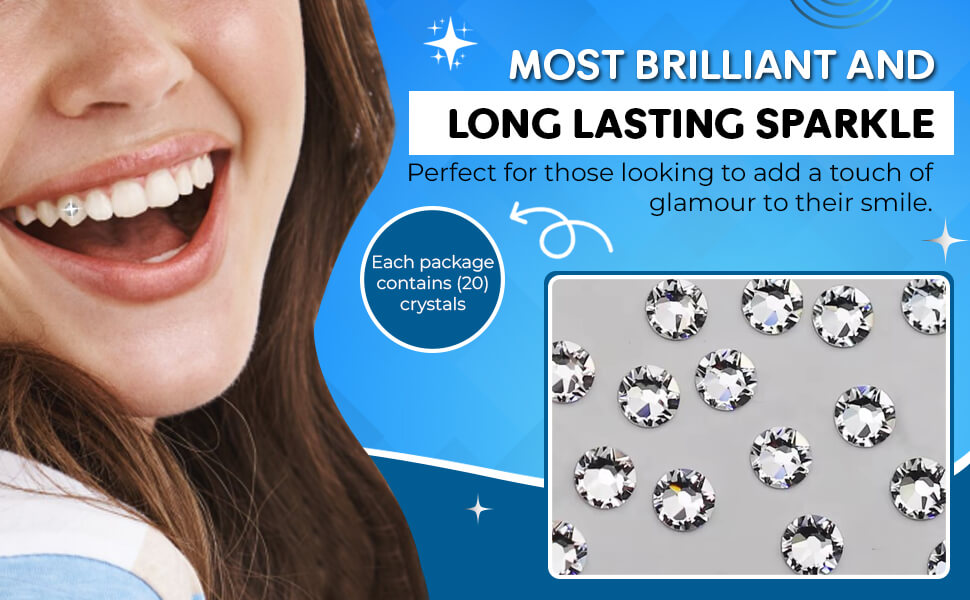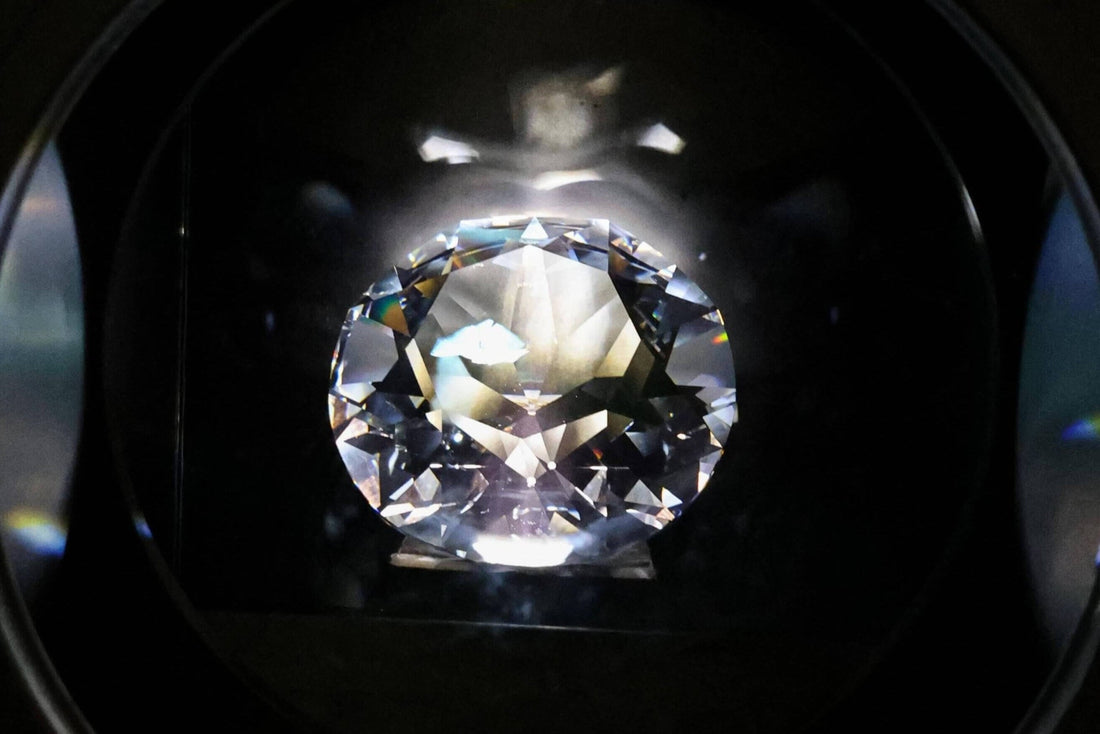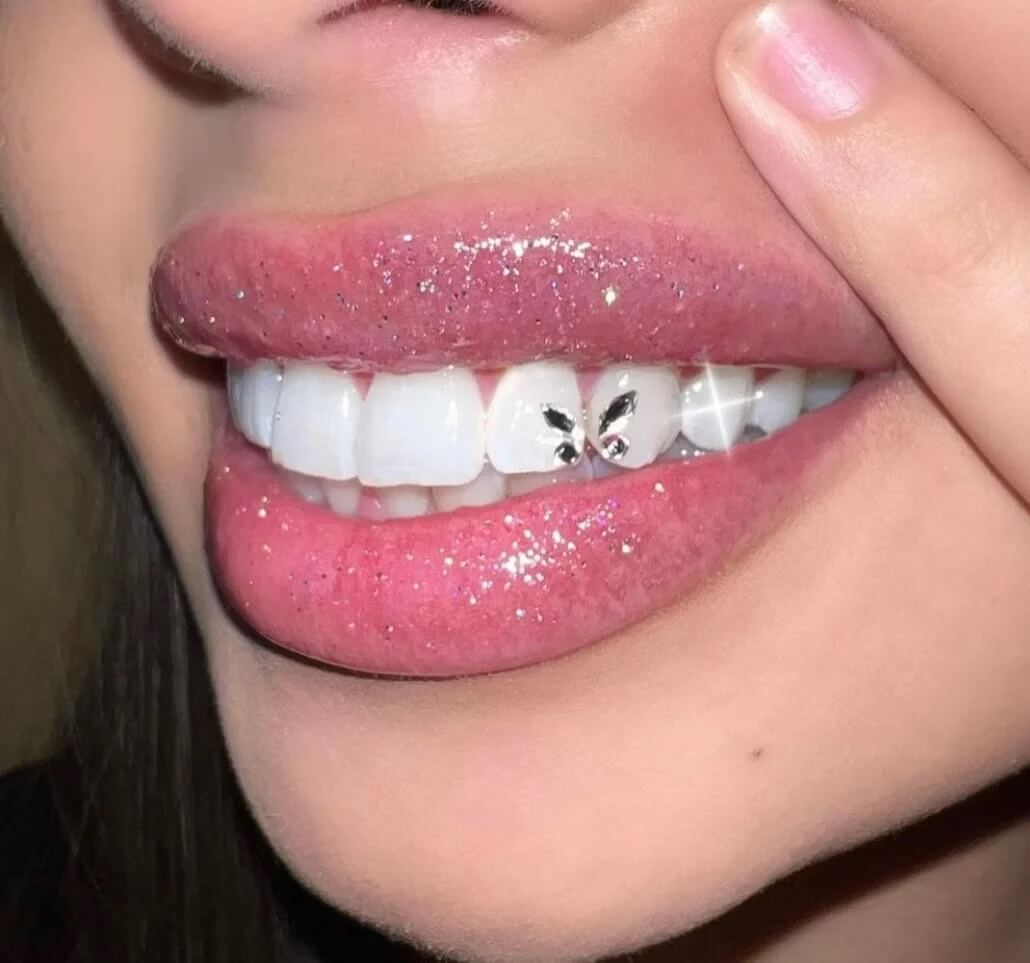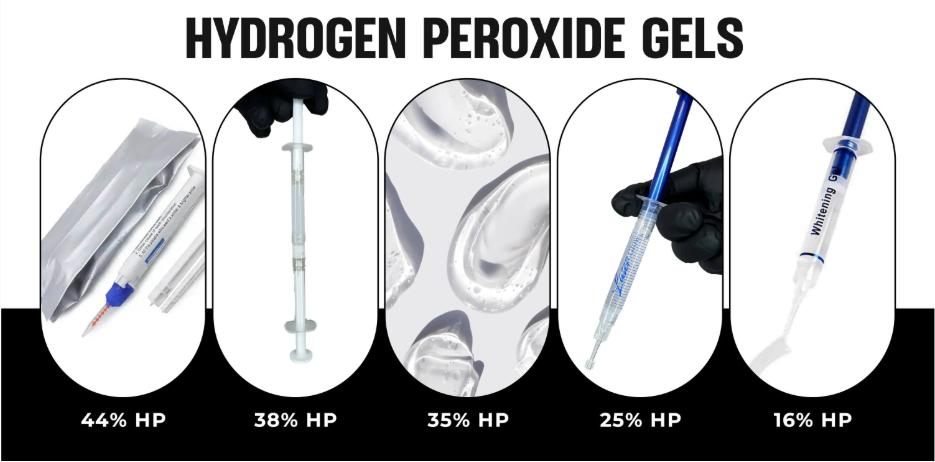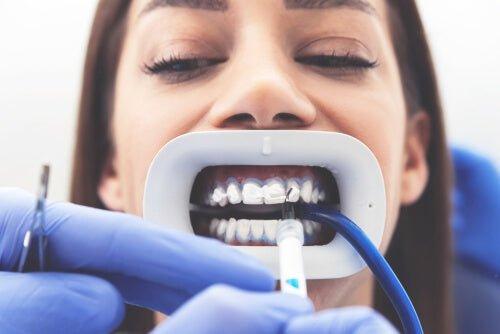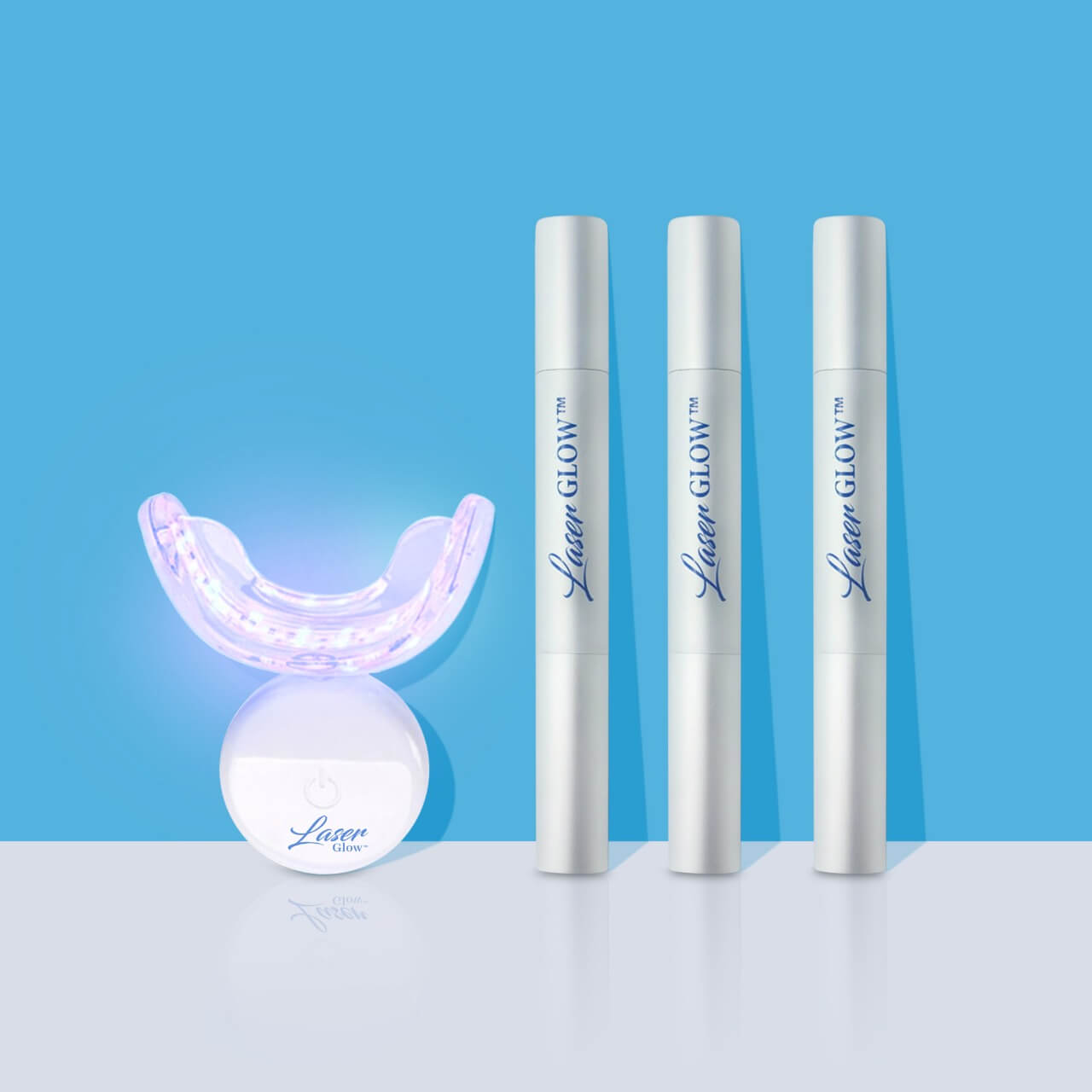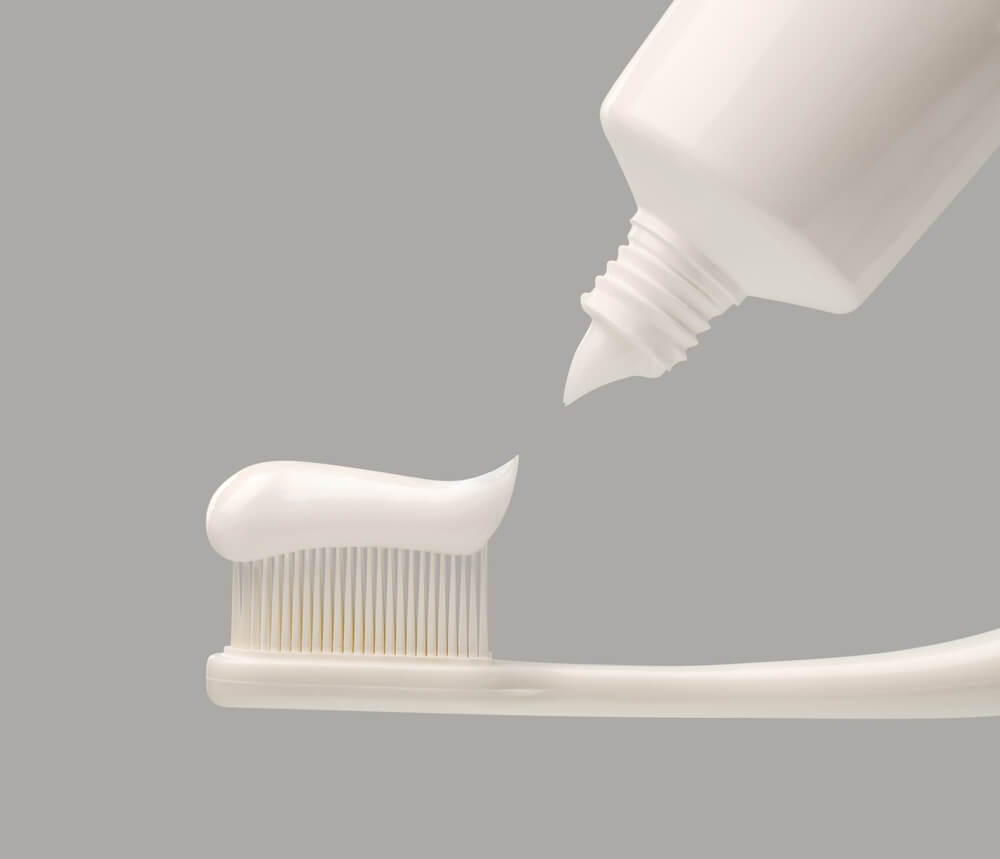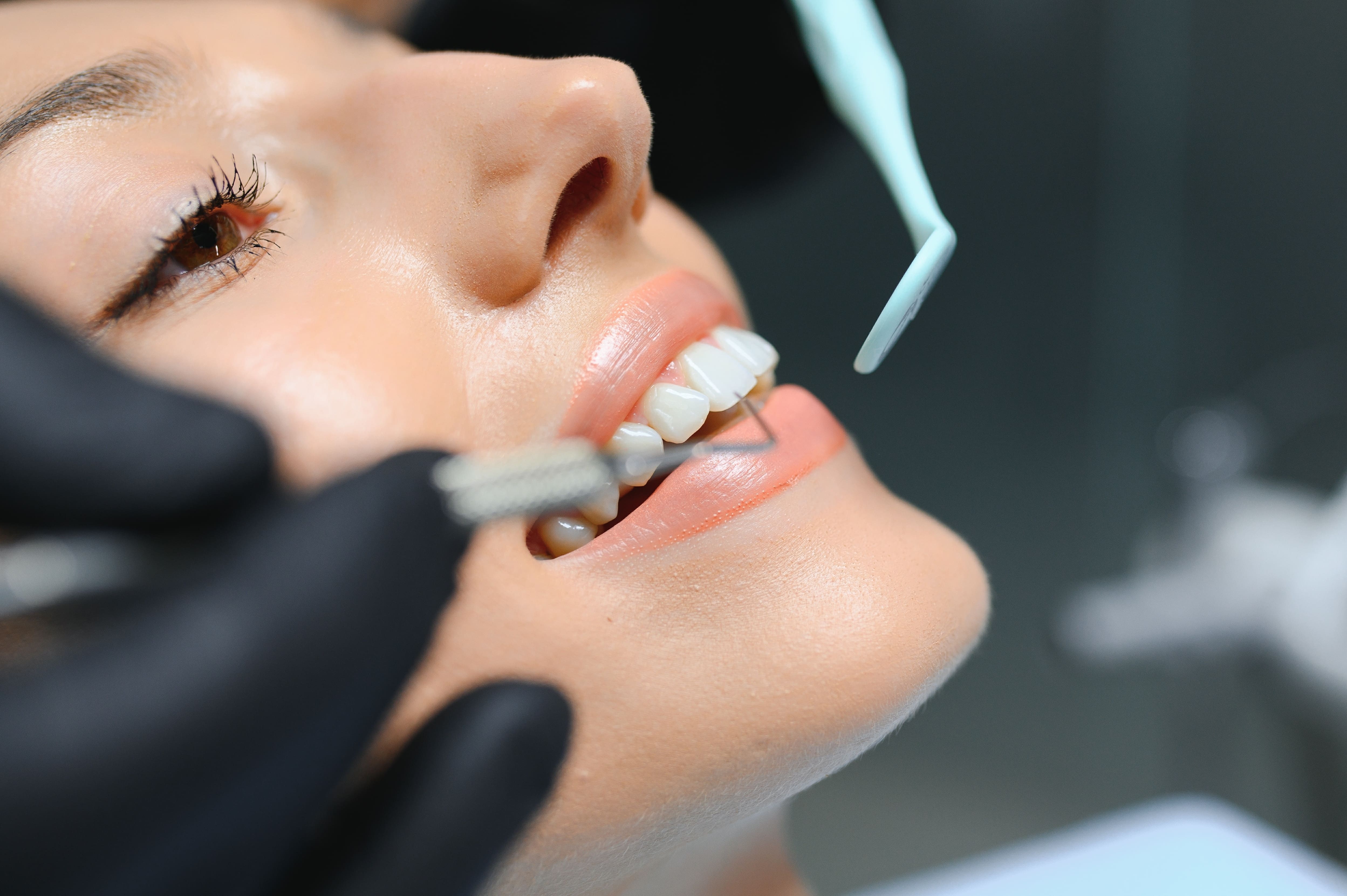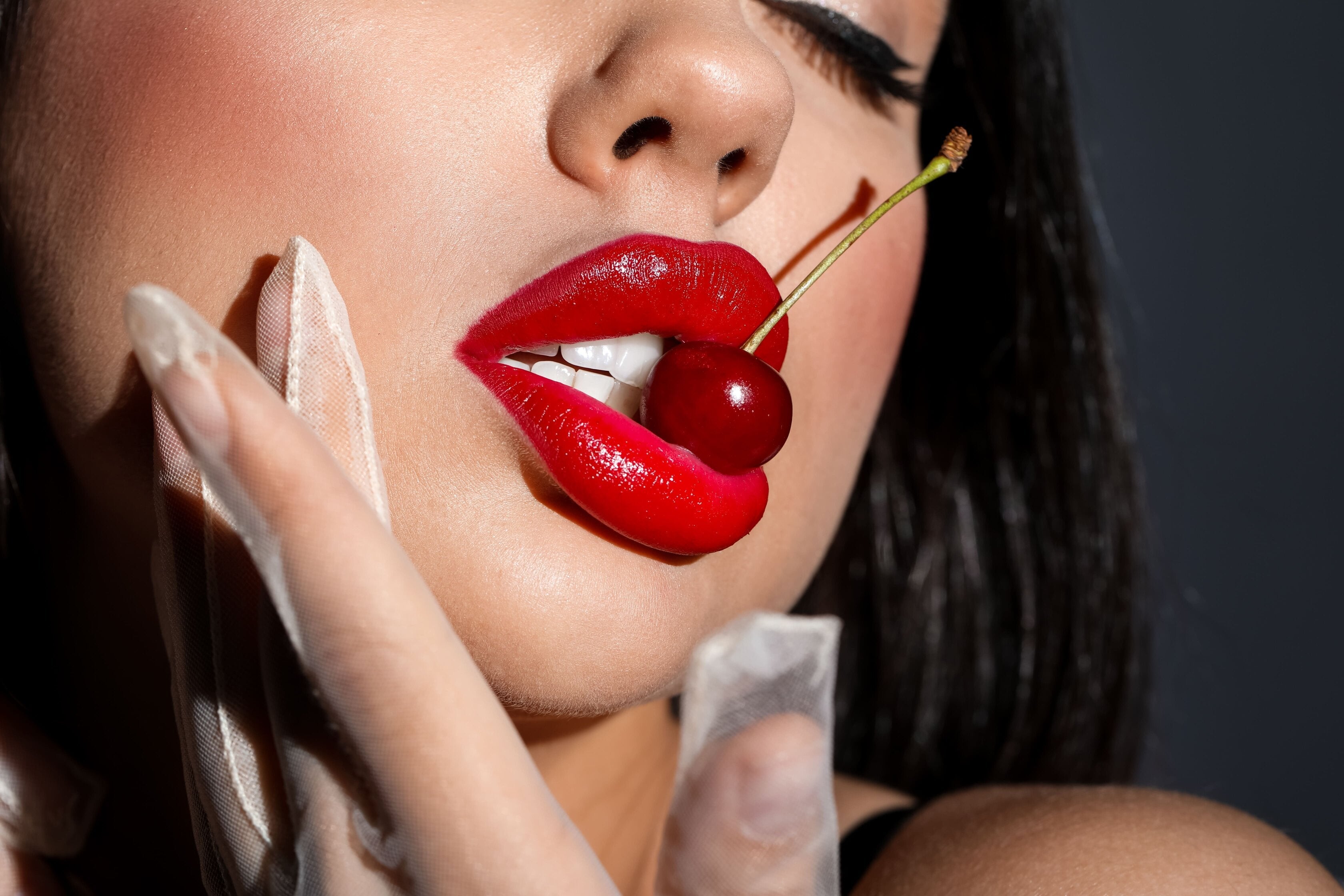LaserGlow Teeth Whitening Blogs & Oral Care Tips | Expert Advice
How Much Do Tooth Gems Cost in 2025? Price Trends & Tips | LaserGlow
2025 Price Trends From subtle single crystals to bold designer shapes, here’s what you can expect to spend on tooth gems this year — plus a few insider tips for getting the best value and keeping your sparkle longer. Tooth gems are no longer just a celebrity trend — they’ve become a staple in self-expression and smile styling. But if you’re new to the look, one question always comes up: how much do they cost? Let’s break down the numbers, the factors that affect them, and how to make sure your investment lasts as long (and shines as bright) as possible. For a complete overview — including safety, removal, and longevity — check our Professional Tooth Gem Pricing Guide. 💰 Average Tooth Gem Pricing Single Crystal Placement: $50–$150 Custom Multi-Gem Designs: $150–$500 Gold, Heart, or Butterfly Shapes: $200–$1000+ DIY Kits: $20–$60 (short-term use) Most professional placements include a quick consult, design selection, and aftercare guidance. Prices rise with gem quality, design detail, and technician expertise. 📊 What Affects Tooth Gem Cost? Gem Type: Swarovski, gold, or diamonds each have different base costs. Design Complexity: Single crystals vs. clusters or logos. Technician Skill: Licensed hygienists or trained techs charge slightly more but ensure enamel-safe results. City & Studio Location: Major metro areas often price higher. Longevity: Premium adhesives and curing lights add to the cost but extend wear time. See the science behind longer wear in our Tooth Gem Longevity Guide. ⚖️ Professional vs DIY — Which Is Worth It? While DIY kits seem cheaper, they rarely match the durability or enamel protection of professional bonding. A certified tech uses dental-grade etch, bond, and LED curing for precise adhesion. Professional: Lasts 3–12 months+, enamel-safe, polished finish. DIY: Quick fix for photoshoots, lower retention, higher risk of fall-off. Want a complete set of professional tools and adhesives? Shop Tooth Gem Kits & Supplies → 💎 Are Tooth Gems Worth the Price? Absolutely — when applied correctly, they’re a safe, semi-permanent way to elevate your smile. Like any aesthetic service, the key is quality materials and expert technique. Most clients say the confidence boost alone makes it worthwhile. When you’re ready to switch styles or remove it, a quick polish by a professional keeps your enamel flawless. Need removal advice? Read our Tooth Gem Removal Guide. ✨ Final Thoughts In 2025, expect to spend around $50–$250 for single-gem applications — and more for designer or gold options. Choose licensed providers, ask about enamel-safe bonding materials, and follow proper aftercare to keep your gem looking bright for months. For professional tips, bonding protocols, and full safety insights, visit the LaserGlow Tooth Gem Resource Hub. Reviewed by David Hanna, RDH – Licensed Dental Hygienist, 10+ years’ experience in cosmetic and preventive dental care.
Learn moreAre Tooth Gems Bad for Your Teeth? What Pros Recommend | LaserGlow
Real-World Guidance Short answer: tooth gems can be enamel-safe when applied with professional materials and removed correctly. The real risks come from low-quality adhesives, untrained application, and DIY removal. Use this myth-busting guide to decide confidently—then see our clinical Aftercare & Safety page for the technical details. Reviewed by David Hanna, RDH Think of tooth gems like semi-permanent jewelry for your smile. Done well, they’re temporary, non-invasive, and confidence-boosting. Done poorly, they can irritate gums, trap plaque, or scratch enamel. Below, we separate myths from facts, give you a quick safety checklist, and flag situations where you should wait. Need the clinical protocol, hygiene steps, and enamel-safe do’s & don’ts? Read our Professional Aftercare & Safety Guide (evergreen resource hub). 🔎 Myth vs Fact Myth: “Tooth gems drill into your teeth.” Fact: Proper application is non-invasive—no drilling on sound enamel. A dental-grade resin bonds the gem to the surface and can be polished off professionally. Myth: “They ruin enamel.” Fact: Enamel issues usually trace to wrong adhesives or DIY removal. With pro materials and correct removal, your enamel should remain smooth and intact. Myth: “You can use nail glue—it’s the same.” Fact: Household glues can irritate gums and stain enamel. Only use products intended for teeth and applied by trained providers. Myth: “Brushing will knock it off.” Fact: With a proper bond and curing, normal brushing is fine. Focus on gentle passes around edges and keep flossing as usual. ✅ Safety Decision Checklist (2 Minutes) Provider: Are they trained or licensed? Do they explain etch/bond/LED curing and aftercare? Materials: Are the gems and adhesives designed for teeth (not craft gems or nail glue)? Placement: Is the location low-stress (not biting edges) and free of cracks or existing restorations? Hygiene Plan: Do you understand brushing, flossing, and what to avoid in the first 24 hours? Exit Plan: Do they offer professional removal and polish when you’re ready? Want pro-level longevity tips instead of DIY hacks? See our Longevity & Maintenance Guide. 🛑 Who Should Wait (and Red Flags) Active cavities, untreated gum disease, or cracked teeth—fix these first. New orthodontic attachments or recent whitening (wait for sensitivity to subside). High-contact sports without a mouthguard. Any provider who can’t name their adhesive system or offers to use “super glue.” Red flag: Pain, ongoing sensitivity, or a rough edge catching floss—schedule a professional evaluation and polish. 🧠 What Professionals Emphasize Dental professionals are generally cautious about unregulated adhesives and DIY removal—not about the concept of tooth gems themselves. The consensus: use dental-intended materials, follow proper bonding steps, and rely on professional removal. Want the enamel-safe routine and post-care steps? Open the Aftercare & Safety Guide → 🩵 Safer Choices Start with Better Materials If you’re shopping, choose gems and kits intended for teeth—never craft crystals or household glues. Premium Crystal Tooth Gems — brilliant clarity designed for smiles Tooth Gem Kit (Etch • Bond • Adhesive) — professional-grade system Removal Tool (Pro) — for trained providers only ✨ Bottom Line Tooth gems can be safe for enamel when you choose a trained provider, dental-intended materials, and proper aftercare. Skip shortcuts, book professional removal, and you’ll enjoy the sparkle—minus the stress. Reviewed by David Hanna, RDH – Licensed Dental Hygienist.
Learn moreHow Long Do Tooth Gems Really Last? Real-World Timelines & Tips | LaserGlow
Real Timelines A practical look at everyday wear: real-world timelines, habits that help or hurt retention, and a simple 3-step plan to get the most months out of your sparkle. For clinical bonding science, see our professional Longevity guide. Reviewed by David Hanna, RDH Most clients ask this first: “Will it stay for my vacation? For the semester?” The truth is that longevity isn’t a single number—it’s a mix of materials, placement, and your daily habits. Want the technical protocol (surface prep, cure times, edge sealing)? Read the Professional Longevity & Maintenance Guide in our Resource Hub. 📅 Real-World Longevity Snapshots Scenario Typical Wear Time Notes Single crystal, professional bond 6–12+ months Best-case if placed away from biting edges and cured thoroughly. Shaped gem (heart/butterfly) 4–10 months More edge area; gentle brushing around contours helps. DIY kit (home application) 3–6 months Shorter retention from simplified prep and curing. High-stress placement (biting edge) 1–4 months Chewing forces and micro-chipping shorten lifespan. 🧠 Habits That Help (and Hurt) Retention Helps Soft-bristle brushing around edges (not across the gem) Avoiding hard biting on the gem for 24–48 hours Rinsing after sticky or acidic snacks Nightguard if you grind/clench Hurts Chewing ice, biting nails, or opening packages with teeth Constant tongue/finger picking at the gem Skipping polish if the edge feels rough Applying over cracked enamel or old bonding Worried about safety instead? Read our lifestyle explainer: Are Tooth Gems Safe? ✅ 3-Step Plan to Make It Last Longer Choose placement wisely: Ask for a low-stress spot away from biting edges. Protect day 1: Avoid hard bites and hot/sticky foods for 24–48 hours. Maintain edges: If it ever feels “catchy,” book a quick polish—don’t pick. Want pro-level tips (cure times, edge seal, moisture control)? Open the Professional Longevity Guide → 🩵 If Your Gem Falls Off Don’t panic—properly applied gems usually leave enamel intact. If you feel roughness or sensitivity, schedule a quick polish. Ready for a refresh? Reapply with a fresh kit or book a professional for maximal wear. Thinking about a change? See our Tooth Gem Removal Guide. 💎 Materials Matter Longevity starts with quality gems and adhesives designed for tooth surfaces—never craft crystals or household glues. Premium Crystal Tooth Gems — clarity and cut for smiles Tooth Gem Kit (Etch • Bond • Adhesive) — professional-grade system LED Curing Light — consistent cure for stronger bonds ✨ Bottom Line Expect 3–12 months in most cases—longer with smart placement, quality materials, and simple care. Treat your gem like semi-permanent jewelry: protect it on day one, avoid stress habits, and let a pro handle polish or removal. Reviewed by David Hanna, RDH – Licensed Dental Hygienist.
Learn moreYour Toothbrush Might Be Making You Sick – 5 Benefits of Using a UV Toothbrush & Razor Sanitizer
Most of us don’t think twice about the cleanliness of our toothbrush or razor. After all, these tools are meant to keep us clean. But did you know your everyday oral hygiene tools could be crawling with germs? Research shows that an uncovered toothbrush can harbor over 100 million bacteria, including E. coli and Staphylococcus. Nasty microbes like the flu virus, strep, yeast, and more have all been found lingering on used toothbrushes. If that isn’t alarming enough, consider that those germs could be making you sick or hindering your recovery from illness. In this article, we’ll explore how your toothbrush (and razor) might be exposing you to illness, and why a UV toothbrush & razor sanitizer is the game-changing solution. We’ll also dive into 5 little-known benefits of using a UV sanitizer that can upgrade your health and hygiene. How Your Toothbrush (and Razor) Might Be Making You Sick Your toothbrush is far from sterile – in fact, it’s a germ magnet. Researchers at England’s University of Manchester found that one toothbrush left out in the open can accumulate tens of millions of bacteria. Similarly, a U.S. study noted up to 1.2 million bacteria on a single toothbrush and that 70% of used toothbrushes are contaminated. These aren’t just harmless mouth bacteria either. Experts have detected some of the nastiest pathogens on toothbrush bristles, from flu viruses and strep to E. coli and Staph bacteria. Every time you brush, you could be reintroducing these microbes into your system. Why are toothbrushes so germy? The problem often lies in how and where we store them. Bathrooms provide a perfect storm for bacterial growth – they’re warm, moist, and steamy. If your brush sits out on the sink or in a cup near the toilet, it’s exposed to a barrage of airborne microbes. Every flush of the toilet can launch a spray of bacteria into the air (gross, but true!), which can land on your toothbrush. In fact, experts call the bathroom “the most infectious environment” in a home, thanks to high humidity and all those airborne germs. A damp toothbrush stored in a dark cabinet or next to other brushes is an ideal breeding ground for microorganisms. Cold and flu viruses, and even bacteria that cause gum disease (gingivitis), can transfer from brush to brush when toothbrushes are stored together. So if a family member is sick, their germs might hop onto your toothbrush if it’s nearby. It’s not just toothbrushes – your razor can be a culprit too. Think about it: razors often sit in the same bathroom environment and come into contact with skin and hair. Rinsing the blade after shaving removes visible gunk, but microbes remain. In just a few weeks, a razor left in a humid bathroom could gather millions of bacteria on the blade. The next time you shave, those bacteria transfer straight onto your skin. This can lead to razor burn, folliculitis (infected hair follicles), or even serious skin infections like cellulitis. Dermatologists warn that using an old, bacteria-laden razor increases the risk of rashes, irritation, and infections. In short, an unhygienic razor might be undoing your skin care efforts by introducing harmful germs. Now, you might be thinking: Will these germs actually make me sick? The good news is that our immune systems usually defend us against everyday bacteria. But “usually” doesn’t mean always. If you happen to have a weaker immune system, or you’re recovering from a sickness like the flu or strep throat, using a germy toothbrush could reinfect you or prolong illness. And even if you stay relatively healthy, no one wants to put a bacteria-loaded brush in their mouth twice a day – it’s bad for oral health (those bacteria can contribute to gum disease and bad breath) and just plain unsettling. Bottom line: Your toothbrush might be making you sick, or at least exposing you to microbes that you don’t want in your body. The same goes for that razor in the shower. So what’s the solution? Practicing good hygiene with your oral care tools is key. That includes steps like rinsing your brush thoroughly, letting it air-dry, storing it away from the toilet, and replacing it every 3-4 months (or after you’ve been ill). But beyond these basics, there’s a high-tech helper you might not have considered: an ultraviolet (UV) sanitizer. Why You Need a UV Toothbrush & Razor Sanitizer Imagine being able to eliminate 99% of those nasty germs before they ever reach your mouth or skin. That’s exactly what a UV toothbrush and razor sanitizer can do. These devices use ultraviolet-C light – the same germicidal light used in hospitals and water purification – to zap bacteria, viruses, and mold on your toothbrush bristles and razor blades. UV-C light works by destroying the DNA or RNA of microorganisms, rendering them inactive and harmless. With a UV sanitizer, you can sterilize your toothbrush after each use, so you’re not scrubbing your teeth with yesterday’s germs. How effective are UV sanitizers really? Studies published in dental journals show that ultraviolet toothbrush sanitizers significantly reduce the number of bacteria and microorganisms living on your brush. In other words, they do what they promise – they kill germs with UV light. While no method (short of industrial sterilization) can remove every single microbe, the best UV sanitizing devices can eliminate up to 99.9% of bacteria, viruses, and yeast on your toothbrush. That’s a huge reduction in germs. To put it in perspective, if your brush started with one million bacteria, a 99.9% kill rate leaves only about 1,000 bacteria – a night-and-day difference. Several clinical studies – notably by Dr. R. Tom Glass, a professor of oral pathology – confirm that deadly microorganisms can incubate on toothbrushes, and that UV sanitization is highly effective (99.9%) in killing those pathogens. Toothbrushes illuminated under germ-killing UV light. UV-C sanitizers can eliminate up to 99.9% of bacteria, viruses, and mold on your toothbrush, keeping it far cleaner than simple rinsing. Not only do UV sanitizers kill germs, they do so quickly and without chemicals. Just place your toothbrush (and even your razor head) inside the device, press a button, and in a few minutes the UV-C light neutralizes the germs. There’s no need to soak your brush in mouthwash or hydrogen peroxide (which can be messy and time-consuming), and no need to boil it (which can damage the bristles). In fact, experts warn that methods like microwaving or boiling your toothbrush can warp the brush or make it unusable. A UV sanitizer avoids that by using light only – no heat, no moisture, no chemicals. It’s a safe and gentle process for your toothbrush and razor, but deadly for microbes. By now, the case for UV sanitizers is pretty clear: they dramatically reduce germs and are easy to use. But that’s not all. Let’s look at five benefits of using a UV toothbrush & razor sanitizer that you might not know – especially if you’re on the fence about whether it’s worth it. These benefits go beyond just “it cleans your toothbrush” and highlight how a UV sanitizer can improve your health, wellness, and even peace of mind. 5 Benefits of Using a UV Toothbrush & Razor Sanitizer You Might Not Know Eliminates 99.9% of Germs for a Healthier You: A UV sanitizer zaps the vast majority of bacteria, viruses, and fungi lurking on your toothbrush and razor. Lab studies have proven that quality UV sanitizers can kill up to 99.9% of illness-causing microbes on your toothbrush. This includes dangerous pathogens like flu viruses, staph bacteria, E. coli, mold spores – you name it. By killing these germs, you’re significantly lowering the risk that your toothbrush or razor will make you sick. You’ll brush with a virtually germ-free brush every time, which means you’re not introducing yesterday’s bacteria into your mouth. Over time, this can help protect you from stomach bugs, colds, or skin infections that might have been transmitted via a dirty tool. It’s like giving your oral care routine a hospital-grade hygiene upgrade at home. Prevents Illness and Reinfection: Have you ever gotten over a cold or flu, only to catch it again shortly after? One culprit might be your toothbrush. Viruses can survive on a moist toothbrush for days, potentially leading to re-infection. A UV toothbrush sanitizer breaks this cycle by neutralizing viruses and bacteria after each use, so you’re not re-exposing yourself to old germs. This is especially beneficial if someone in your household is sick – UV light will help prevent their germs from hopping to your brush (or vice versa). In fact, using a sanitizer can protect your family from illness caused by cross-contamination between toothbrushes. It’s an extra layer of defense, on top of regular hand-washing and hygiene, to keep everyone healthier. While nothing can guarantee you’ll never get sick, eliminating one major source of germs certainly stacks the odds in your favor. Improves Oral Health (and Even Breath): By killing bacteria on your toothbrush, a UV sanitizer may also benefit your teeth and gums. Harmful oral bacteria – the kind that cause gum inflammation (gingivitis), cavities, and bad breath – often hitch a ride on toothbrush bristles. If you don’t sanitize, you might be reintroducing those culprits every time you brush, undermining your oral care efforts. UV light helps ensure you start each brushing session with a truly clean brush, which means less bad bacteria in your mouth overall. This can contribute to healthier gums and fresher breath. In fact, researchers have noted that bacteria causing gingivitis can transfer from one toothbrush to another in close quarters, implying that a dirty brush could spread gum disease. Using a UV sanitizer keeps bacterial levels low, supporting what you’re already doing with flossing and brushing to maintain a healthy smile. Think of it as boosting your oral hygiene to the next level by removing microbes that cause plaque, tartar, and odor. Safe, Chemical-Free Sanitizing (No Damage to Your Brush): One of the great advantages of UV sanitizers is that they’re completely chemical-free. You don’t need to use alcohol rinses, boiling water, or bleach (please don’t use bleach on your toothbrush!) to disinfect your toothbrush. UV-C light gets the job done with no harsh agents and no residue. This not only protects you from possibly ingesting chemical cleaners, but it also protects your toothbrush and razor from damage. Dental experts point out that methods like dishwashers or microwaves can kill germs but also risk melting or deforming your toothbrush bristles. In contrast, UV sanitizing is gentle on materials. The devices are designed to hold your toothbrush (manual or electric head) at a safe distance from the UV lamp, ensuring effective germicidal action without physically harming the brush. Also, consider the cost savings: over time, using a UV sanitizer might save you money on mouthwash or disinfectant solutions that you’d otherwise buy to soak your toothbrush. The UV device is a one-time investment that keeps working day after day with just light. It’s a convenient and eco-friendly solution too – many sanitizers turn off automatically after a few minutes and use minimal electricity or batteries. Keeps Razors Clean for Better Skin: A big bonus of a combo UV toothbrush & razor sanitizer is that it doesn’t only look after your toothbrush – it also keeps your razor blades hygienic. As mentioned earlier, razors can breed tons of bacteria that cause skin irritation and infections. By regularly sanitizing your razor with UV light, you ensure that each shave is with a clean blade. This can dramatically reduce razor burn, rashes, and clogged pores, since you’re not dragging a bacteria-laden blade across your skin. Think about it: a clean razor blade gives a smoother shave and minimizes the chance of those post-shave red bumps. Dermatologists note that using a dirty, dull razor can lead to folliculitis and even abscesses if bacteria enter nicks in the skin. With a UV sanitizer, you’re proactively killing those blade-coating germs before they ever reach your skin. That means healthier skin and fewer shave-related infections. Plus, a dry, sanitized razor blade might even last longer (no gross bio-film eating away at it), saving you money on replacement blades. For anyone prone to acne or sensitive skin, sanitizing your razor is a game changer – you’re removing a sneaky source of breakouts and irritation. Your face (and body) will thank you for it! Conclusion: A Simple Upgrade for a Healthier Routine Your toothbrush and razor are essential parts of your daily routine – don’t let them become the weak link in your hygiene. As we’ve seen, these tools can harbor a shocking number of germs that you wouldn’t want anywhere near you. The good news is that a UV toothbrush & razor sanitizer offers a simple, effective remedy. It keeps your oral care and grooming tools 99% germ-free, giving you extra protection against illness, better oral health, and clearer skin. It’s an easy upgrade that brings some cutting-edge technology into your bathroom and a lot of peace of mind along with it. If you’re ready to elevate your hygiene and health, consider investing in our UV Toothbrush & Razor Sanitizer. It’s designed to accommodate your toothbrush (manual or electric) and razor, bathing them in germicidal UV-C light so that they’re fresh and clean for every use. Using one is as simple as brushing your teeth: just place your items in the sanitizer, press start, and in a few minutes you have a sanitized toothbrush and razor ready to go. No more wondering what invisible nasties are lurking on your brush, and no more risking your health on “toothbrush roulette.” Stay healthy, stay hygienic! Your oral care routine will never be the same once you experience the confidence of knowing your toothbrush isn’t secretly making you sick. With a UV sanitizer, you can brush and shave with the assurance that you’re using truly clean tools each time – a small change that can make a big difference for your overall wellness and the health of your family. Boost your daily routine by cutting down those germ colonies and enjoying fresher, safer brushing and shaving. Your mouth and skin will thank you, and you’ll wonder how you ever went without this clever gadget. After all, when it comes to your health, an ounce of prevention (or in this case, a few minutes of UV light) is worth a pound of cure! FAQ Do UV toothbrush sanitizers really work?Yes, clinical studies show UV sanitizers kill up to 99.9% of bacteria, viruses, and mold on toothbrushes and razors. Is UV light safe for toothbrushes and razors?Yes, the exposure is short and designed to sanitize effectively without damaging your tools. How often should I sanitize my toothbrush?Ideally after every use. A quick UV cycle ensures your brush is germ-free before the next time you use it. Can a UV sanitizer prevent illness?While no device can guarantee you’ll never get sick, eliminating bacteria and viruses from your toothbrush and razor significantly reduces your risk.
Learn moreHydrogen Peroxide vs. Carbamide Peroxide: Which Whitening Gel Should Professionals Use?
Both hydrogen peroxide (HP) and carbamide peroxide (CP) are widely used in professional teeth whitening – but they aren’t identical. If you’re a dentist, esthetician, or whitening technician, understanding the differences between these two bleaching agents is key to choosing the right product for each client. In this article, we’ll compare hydrogen peroxide vs. carbamide peroxide gels in terms of chemical makeup, how quickly they work, client comfort and sensitivity, typical use cases, and safety considerations. Chemical Differences Between Hydrogen Peroxide and Carbamide Peroxide Hydrogen peroxide (H2O2) is the direct bleaching agent that whitens teeth by releasing oxygen molecules. Carbamide peroxide, on the other hand, breaks down into hydrogen peroxide plus urea, releasing its whitening power more slowly. A 30% carbamide peroxide gel yields about 10% hydrogen peroxide once decomposed. Professionals should remember the 1:3 conversion ratio when comparing strengths. Speed of Whitening and Treatment Time Hydrogen peroxide works fast, making it ideal for in-office whitening sessions. A 25–35% HP gel can show results in under an hour. Carbamide peroxide, by contrast, is the marathon runner—designed for longer, sustained whitening through overnight trays or multi-week regimens. Client Comfort and Sensitivity Hydrogen peroxide provides rapid whitening but can cause short-term sensitivity. Carbamide peroxide is gentler, releasing peroxide gradually for patients with sensitive teeth. CP is often recommended for overnight tray use, while HP is best suited for immediate results. Professional Use Cases In-Office Whitening (Immediate Results): Hydrogen peroxide gels (25–35%) are ideal for same-day whitening. Take-Home Whitening Kits (Gradual Results): Carbamide peroxide gels (10–22%) are best for safe, long-duration whitening at home. Sensitive Clients: Opt for carbamide peroxide or lower-concentration hydrogen peroxide. Resistant Stains: Use extended carbamide peroxide regimens, sometimes combined with hydrogen peroxide jump-starts. Safety and Best Practices Both gels are safe when used correctly. Hydrogen peroxide requires gingival barriers and careful application to avoid burns, while carbamide peroxide requires well-fitted trays to prevent leakage. Both should be paired with proper aftercare advice (sensitivity toothpaste, avoiding staining foods for 24–48 hours, etc.). Explore Professional Whitening Gels LaserGlow offers a full range of professional whitening gels including hydrogen peroxide, carbamide peroxide, and peroxide-free PAP+ options to fit every client need. FAQs Which whitens better? Both HP and CP achieve similar end results; HP is faster, CP is gentler and longer-lasting. Is carbamide peroxide safer? It’s gentler on sensitivity, but both are safe under professional use. How do I convert percentages? Use the 1:3 ratio: 30% CP ≈ 10% HP. Do I need a light? Lights are optional but commonly used with HP for enhanced results. Can I use both? Yes—many professionals combine HP in-office with CP at-home kits. When to avoid? Avoid whitening during pregnancy, in children, with untreated dental issues, or on restorations.
Learn moreHow to Choose the Right Whitening Gel Strength (16% vs 25% vs 35% vs 44%)
Not sure which teeth whitening gel strength to choose? This guide breaks down the differences between 16%, 25%, 35%, and 44% hydrogen peroxide gels—explaining which is best for sensitive teeth, which delivers the fastest results, and how to safely use each with LED/laser systems. Perfect for dentists, estheticians, and whitening technicians, it’s your go-to resource for matching gel strength to client needs while ensuring safe, comfortable, and dazzling results.
Learn moreCan You Whiten Veneers? How to Remove Stains from Porcelain & Composite Veneers
Porcelain and composite veneers give you a bright, flawless smile – but over time you might notice them losing a bit of luster. Many patients wonder, “Can you whiten veneers once they stain?” The truth is that veneers don’t respond to bleaching gels like natural teeth do. However, that doesn’t mean you’re out of options. In this comprehensive guide, we’ll explain why veneers can appear discolored, how to safely remove stains from veneers, and what you can do to keep your veneer-enhanced smile white for years to come. We’ll also answer all the frequently asked questions about whitening veneers, so you can protect your investment and confidently show off your smile. Can You Whiten Veneers with Teeth Whitening Products? The short answer is no – you cannot whiten the veneer material itself using typical peroxide whitening products. Unlike natural tooth enamel, which is porous, dental veneers are made of non-porous materials (porcelain or composite resin) that do not respond to bleaching agents. Even high-strength whitening gels or strips will not penetrate or alter a veneer’s color. Attempting to bleach veneers at home won’t make them any whiter, and it could irritate your gums or damage your natural teeth without any benefit to the veneers. Standard whitening treatments only work on natural tooth structure, so applying them on veneers is ineffective. In fact, dentists and the American Dental Association caution that while veneers are generally stain-resistant, “they cannot be lightened once they begin to change color”. That said, your smile is not doomed to discoloration just because you have veneers. What can be whitened is often the tooth structure around or behind the veneers, and surface stains that build up on the edges of veneers over time. In the next sections, we’ll look at why veneers might appear dull or yellow as years go by – and how to safely refresh them. Why Do Veneers Look Discolored Over Time? High-quality porcelain veneers are designed to be stain-resistant. In fact, porcelain is a glass-like ceramic that doesn’t pick up pigment easily. Composite resin veneers (and bonding) are a bit more porous, so they can stain slightly faster than porcelain. But all veneers can start to look less bright after many years due to several factors: Surface Stains at the Margins: Dark-colored foods and drinks – coffee, tea, red wine, curry, berries, tobacco – can leave micro-deposits on the tiny seam where the veneer meets your tooth. Over months and years, these pigments accumulate in the edges and between teeth, making the borders of each veneer appear yellow or shadowed. Aging of Bonding Cement: The adhesive resin that bonds the veneer to your tooth can discolor over time. As this dental cement ages or if your gumline recedes exposing it, you might see a darker line or slight color change at the top of the veneer. Natural Tooth Changes: If you had veneers only on some teeth, the surrounding natural teeth might change color (darken or get whiter if you bleach them) and create a contrast. Even the tooth behind a translucent veneer could darken slightly with age. This can make the veneer look less bright by comparison. Wear and Surface Roughening: Years of brushing and consuming acidic foods can very slowly wear down the ultra-thin glaze on a porcelain veneer or the polish on a composite veneer. A rougher surface can attract stains more easily. While porcelain veneers are more resistant to discoloration than composites, neither type is 100% immune to the effects of time. Composite veneers in particular may absorb stains and lose luster faster due to their resin makeup. In short, veneers themselves typically don’t deeply yellow the way natural teeth can, but the little things – surface stains, edge discoloration, minor changes underneath – can add up to a smile that isn’t as sparkling white as it once was. The good news is that these types of discoloration can usually be addressed with proper maintenance or professional care, which we’ll discuss next. How to Safely Remove Stains from Veneers Even though you can’t bleach a veneer whiter than its original shade, there are safe and effective ways to refresh your smile if veneers have taken on stains or a dulled appearance. Here are the best practices for whitening the appearance of veneers: 1. Professional Dental Cleanings: Just as your dentist or hygienist polishes your natural teeth, they can also polish the surface of veneers during a routine cleaning. Regular professional cleanings (every 6 months) help remove surface stains and plaque that make veneers look dull. The polishing paste and tools used by dental professionals can gently buff away many extrinsic stains without harming the veneer. This is often the first and easiest step to brighten your veneers. 2. Cosmetic Veneer Polishing: If a basic cleaning isn’t enough, ask your dentist about a dedicated polishing session for your veneers. Dentists have special fine abrasives and polishing discs that can be used on porcelain or composite veneers to restore their glossy shine. This can significantly improve mild staining or surface roughness. Polishing won’t change the inherent color of the veneer, but it can remove buildup and re-smooth the surface, making them appear brighter. 3. Non-Abrasive Stain Removing Toothpaste: Use a toothpaste formulated for veneers or for whitening without abrasives. Ordinary whitening toothpastes might contain gritty particles (or baking soda) that could scratch porcelain over time. Instead, choose a gel-based fluoride toothpaste or one marked “safe for cosmetic dental work.” These often contain gentle polishing agents that help lift surface stains from veneers without eroding their finish. While such toothpastes won’t dramatically whiten a discolored veneer, they can help maintain brightness and prevent new stains. (Avoid charcoal pastes or any “DIY” abrasive scrub on your veneers – more on that in the FAQ!) 4. Specialized Veneer Whitening Treatments: One exciting development is professional veneer stain-lifting sessions – a targeted form of in-office whitening designed specifically for people with veneers. For example, our LaserGlow offices in Clifton and Edgewater, NJ offer a 20-minute veneer touch-up that uses a concentrated hydrogen peroxide gel and LED light to brighten the edges of veneers. Unlike a full teeth whitening session (which can last 60–90 minutes but doesn’t change porcelain), this short treatment focuses only on oxidizing the stains lurking around each veneer. By applying the whitening gel precisely along the margins where veneers meet enamel, we can lift the yellowish tinge from those micro-gaps without “over-whitening” the porcelain itself. Why try a 20-minute veneer whitening? Here are some benefits: Targets Stains at the Edges: The short peroxide application is concentrated on the stained margins instead of the porcelain front, effectively breaking down pigment where it accumulates most. No Color Mismatch: Because the porcelain veneer material isn’t altered, you won’t end up with uneven color. The treatment simply erases the dark shadows so your veneers return to their original shade. Minimal Sensitivity: Less exposure time means less risk of tooth sensitivity after. Many patients find this micro-whitening causes little to no post-treatment soreness, an ideal perk if the teeth under your veneers have thin enamel. Quick & Cost-Effective: In about 20 minutes, you can see a noticeable improvement in veneer brightness. Since you’re only using a fraction of the chair-time and materials of a full whitening session, the cost is often much lower as well. (Nationwide, a standard one-hour in-office whitening can cost $400–$600, whereas a veneer-focused touch-up might be under $200.) This type of specialized treatment is a safe way to refresh your veneers periodically without replacing them. Always ensure it’s done by a dental professional familiar with cosmetic dentistry. 5. Replacing Old Veneers: What if your veneers are truly discolored internally or have had their outer glaze compromised? Unfortunately, no amount of cleaning will fix deep internal stains or intrinsic color changes in a veneer. In rare cases – such as veneers older than 15-20 years, or those damaged by cracks – the best solution might be to replace them with new veneers. This is the most invasive and costly option, so dentists typically reserve it for when veneers are significantly discolored or defective beyond the help of polishing. The upside is that new veneers can be made in a brighter shade if desired. With good care, a new set of porcelain veneers will last a decade or longer before any notable discoloration occurs. Most patients will not need to replace veneers just for mild staining. By using the above methods – regular cleanings, proper toothpaste, occasional professional touch-ups – you can keep your veneers looking nearly as bright as the day they were placed. Pro Tips for Keeping Veneers White While professional treatments can help when veneers get dingy, the ideal scenario is to prevent stains in the first place. Good oral habits will protect both your veneers and your underlying teeth and gum health. Follow these best practices to maintain a radiant veneer smile: Practice Excellent Oral Hygiene: Brush your teeth (and veneers) twice a day with a soft-bristle toothbrush, and floss daily. Plaque buildup can make veneers look dull and also contribute to staining at the edges, so keeping your mouth clean is key. Consider using a water flosser to clean around veneers – water flossers can reach and rinse out plaque from the small nooks around veneer margins more effectively than string floss. Avoid Stain-Causing Foods & Drinks: Limit your consumption of very pigmented items like coffee, black tea, red wine, cola, soy sauce, curry, and berries. When you do enjoy them, rinse your mouth with water afterward or brush if possible to prevent long contact with the veneer surfaces. Using a straw for drinks like iced coffee and tea can also minimize contact with your front teeth. Skip the Tobacco: Do not smoke or chew tobacco if you want to keep your smile bright. Nicotine and tar are notorious for staining dental work. Smoking will yellow your veneers over time and can also stain the bonding material around them, not to mention harm your gums. Quitting tobacco is one of the best things you can do for your veneers (and overall health). Use Non-Abrasive Dental Products: As mentioned earlier, use gentle toothpaste and avoid abrasive pastes or DIY whitening concoctions on your veneers. Products with baking soda, charcoal, or gritty texture can create microscopic scratches in porcelain, making it easier for stains to latch on. Also choose alcohol-free mouthwash – alcohol can weaken the bond of the veneer adhesive over time. Regular Dental Checkups: See your dentist every six months for cleanings and exams. Not only will they polish your veneers, but they’ll also check the integrity of the bonds and look for any issues (like gum recession or decay at the edges) early on. Routine maintenance will keep your veneers and the teeth supporting them healthy and looking good. Consider a Color-Correcting Rinse/Paste: If you need an instant boost before a big event, you can try a purple-tinted whitening toothpaste or mouth rinse as a temporary fix. These products don’t bleach teeth but use color theory (purple cancels yellow) to give a brighter appearance. They are safe on veneers because they simply deposit a slight tint that makes teeth look whiter for a short time. It’s like make-up for your teeth – just be sure to use it as directed and continue your normal cleaning routine too. By following the above tips, you’ll greatly reduce the chances of your veneers getting stained. Prevention is always easier than cure when it comes to keeping cosmetic dental work pristine. Veneer Teeth Whitening in NJ & FL – A 20-Minute Solution If you’re looking for a quick, safe way to refresh your veneers and you live in New Jersey or South Florida, our team can help. LaserGlow offers a specialized Veneer Teeth Whitening service available at our offices in Clifton, NJ, Edgewater, NJ, and Miami, FL. In just 20 minutes, our trained dental professionals will lift the stains from around your porcelain or composite veneers using a high-intensity peroxide gel and LED light activation. This targeted treatment is designed specifically for veneers – it brightens the areas around the veneers without changing the veneers’ actual color, so you get a rejuvenated smile that looks natural and even. Our Veneer Whitening touch-up is performed by licensed hygienists, and we use enamel-safe gels with protective measures to ensure your gums and underlying teeth stay healthy throughout the process. Most clients see 1–2 shades of improvement at the veneer margins after one session. If you’re in the Clifton, Edgewater, or Miami area, feel free to contact us to book a consultation or appointment. We’ll help you maintain your veneers and keep your smile glowing! Frequently Asked Questions about Whitening Veneers Can you whiten veneers? No. You cannot whiten the porcelain or composite material of veneers using bleaching treatments like you would natural teeth. Traditional whitening gels “bounce off” the veneer’s non-porous surface without any effect. However, you can improve the overall brightness of your smile by removing stains on the tooth structure around veneers or polishing the veneer’s surface. Professional cleanings or specialized in-office veneer whitening (stain-lifting) treatments are the best way to make veneers look whiter. How can I whiten my veneers at home? Unfortunately, there is no safe or effective at-home method to truly whiten veneer material. Whitening strips, LED kits, or gel trays won’t change a veneer’s color. Even “natural” remedies like baking soda or peroxide won’t whiten veneers – the veneers simply don’t respond to these agents. In fact, abrasive home remedies (baking soda, charcoal, lemon juice, etc.) can end up damaging your veneers or the teeth around them. The best thing you can do at home is maintain excellent oral hygiene: brush and floss regularly, use a non-abrasive toothpaste, and avoid stain-causing foods and smoking. These habits will prevent further discoloration. If your veneers still look dull or yellow, the next step is to visit your dentist for professional cleaning or a veneer-specific whitening service. Do veneers stain or turn yellow over time? Porcelain veneers are very stain-resistant, so they generally do not yellow like natural teeth can. Composite resin veneers are a bit more prone to surface staining over the years. That said, both types can develop slight discoloration at the edges or a duller appearance after long-term exposure to staining agents. Common culprits for veneer staining are coffee, tea, red wine, tobacco, curry, and similar substances. Also, if the adhesive bonding your veneer darkens or your gums recede, you might see a line or gap that looks yellowish. Veneers themselves won’t dramatically change color, but they can lose some brilliance after 10-15 years. Regular dental maintenance and mindful habits will minimize any yellowing. What’s the best way to remove stains from veneers? The most effective way is to have your dentist or hygienist professionally clean and polish the veneers. A thorough polishing can often take off external stains. If stains persist, ask about a specialized veneer whitening or stain-lifting treatment – some cosmetic dentists offer a focused whitening procedure to brighten veneer margins (for example, a 20-minute in-office veneer touch-up). Do not try to aggressively scrub veneers at home (like using baking soda scrubs) as you could scratch them. Always opt for professional care for stain removal on veneers. In extreme cases where a veneer is deeply discolored internally, you may need to replace it with a new one. Will whitening toothpaste or strips work on veneers? Standard whitening toothpastes or whitening strips have little to no effect on veneers. Those products are formulated to remove stains from natural enamel and bleach the enamel’s color. Since veneers are artificial material, strips won’t penetrate them. Whitening toothpastes might help clean around the veneers, but if they contain abrasives they can also wear down the veneer’s shine. If you use a whitening toothpaste, make sure it’s a gentle, non-abrasive type. Overall, don’t expect these products to actually whiten the veneers themselves. They are better used for keeping your surrounding teeth bright so there’s no contrast. Can I use baking soda or charcoal to whiten veneers? No – it’s not recommended. Abrasive substances like baking soda or activated charcoal powder may scour away surface stains, but they also risk scratching your porcelain veneers and damaging the enamel at the margins. Acidic DIY concoctions (like lemon juice or apple cider vinegar) are equally bad, as they can erode the tooth surface around the veneer and even cause the edges of veneers to stain more by roughening them. In fact, dental experts warn that home remedies (lemon, baking soda, etc.) can ironically end up staining veneers or causing other issues. It’s best to stick to dentist-approved cleaning methods for your veneers. Will professional teeth whitening damage my veneers? If you have your teeth professionally whitened (for example, the natural teeth that don’t have veneers), it will not damage the veneers. The whitening gel will simply have no effect on the porcelain, and it won’t harm it. Porcelain is quite inert – peroxide gel passes over it without changing its color or structure. Just be aware that whitening your other teeth could make your veneers appear relatively darker if the veneers were originally matched to a previously darker shade. Also, the whitening process can cause temporary sensitivity in natural teeth, but it should not hurt or weaken your veneers. As always, it’s wise to have whitening done under professional supervision, especially if you have cosmetic dental work. How often should I whiten or polish my veneers? Veneers themselves don’t need whitening, but to keep them looking their best you might want a “touch-up” periodically on the areas around them. Most patients with veneers get a professional cleaning every 6 months, which usually suffices to remove minor stains. If you opt for a specialized veneer stain-lifting session (like the 20-minute whitening touch-up), you might do that once a year or every 6 months depending on your diet and habits. Patients with composite veneers or heavy coffee/red wine use may benefit from more frequent maintenance (e.g. a polishing or touch-up every 3-6 months). Your dentist can recommend an ideal schedule. The key is to avoid letting stains build up too long. With regular care, many veneer wearers find they rarely need anything beyond their routine cleanings to keep a white smile. Do composite veneers stain more than porcelain? Yes. Composite resin veneers are generally more prone to staining than porcelain veneers. Porcelain is highly stain-resistant and maintains its color very well over time. Composite is a plastic-based material that can absorb pigments slightly, so composite veneers may yellow or dull faster, especially if exposed to lots of coffee, wine, smoking, etc. Composite veneers also typically last 5-7 years before they might need refurbishing, whereas porcelain veneers last 10-15 years on average. If you have composite veneers, be extra diligent with hygiene and avoiding stains, and you might need professional polishing or more frequent replacement to keep them at peak brightness. What if my veneers are severely discolored or old? If you feel your veneers have become very discolored deep down (not just surface stains), consult your dentist. They will check if the staining is external or internal. External stains can usually be cleaned off or polished. Internal discoloration – which can happen if a veneer’s glaze is worn or if the tooth behind has darkened – cannot be lightened without altering the veneer itself. In such cases, the dentist might suggest replacing the veneer with a new one, especially if the veneer is at the end of its lifespan. Another scenario is if the edges of veneers are picking up stains due to tiny gaps or cracks; sometimes re-bonding or reglazing the veneer can help. Ultimately, replacing the veneers is the definitive solution for severe or intrinsic discoloration. The new veneers can be made in a brighter shade, so replacing them will definitely whiten your smile, albeit at a higher cost than other options. How much does veneer whitening cost? Simple stain removal is often done as part of a regular cleaning, which might cost around the same as a normal dental visit (depending on your insurance or local rates). If you opt for a cosmetic veneer whitening session, the cost is typically a fraction of a full teeth whitening procedure. For example, an hour-long in-office whitening can cost about $400-$600, and yet it won’t change veneer color. A targeted 20-minute veneer stain-lifting treatment might cost roughly $150-$200 because it’s shorter and focuses only on the stained areas. Prices vary by location and provider, so check with your cosmetic dentist. Replacing veneers entirely is the most expensive option – usually $1000+ per tooth – so it’s worth investing in maintenance to prolong the life of your existing veneers.
Learn moreLaserGlow’s 44% Whitening Gel Named Amazon’s Overall Pick
Big news: LaserGlow’s 44% Hydrogen Peroxide Dual-Barrel Whitening Gel has been recognized as Amazon’s Overall Pick for hydrogen peroxide whitening gels. This top-tier recognition is not just a badge — it’s Amazon’s way of highlighting the best overall product in the category. For dental professionals, whitening technicians, and med-spas, this validation confirms what thousands of satisfied clients already know: LaserGlow leads the teeth whitening market with safe, powerful, professional-grade results. What Does Amazon’s Overall Pick Mean? Unlike automated badges such as “Amazon’s Choice,” the Overall Pick is an editorial recommendation. Amazon itself highlights the product as the top recommendation in its category, based on a combination of: Consistently high star ratings and positive reviews Competitive pricing and strong value Verified sales performance and repeat buyers Proven product reliability and trust Being named Amazon’s Overall Pick means LaserGlow isn’t just popular — it’s trusted, effective, and considered the best whitening gel available. Why LaserGlow Leads the Market Professional-Strength Formula At 44% Hydrogen Peroxide, LaserGlow offers one of the strongest whitening gels available anywhere. It’s engineered exclusively for trained professionals, delivering dramatic whitening results in just one session. Exclusive Dual-Barrel Syringe Technology LaserGlow is the first and only brand worldwide to launch a dual-barrel peroxide system at 44%. By keeping active ingredients separated until use, the gel maintains maximum freshness, potency, and stability, ensuring consistent results every time. Trusted Globally by Professionals From dentists and med-spas in the U.S. to aesthetic clinics worldwide, LaserGlow’s 44% Whitening Gel has become the preferred solution for: Dental practices Whitening technician studios Luxury spas and salons Cosmetic clinics This Amazon recognition further validates its standing as the go-to whitening gel for professionals. The Science Behind 44% Hydrogen Peroxide Whitening Gel Hydrogen Peroxide has long been the gold standard for whitening in dentistry. At 44% concentration, LaserGlow’s gel penetrates enamel, breaking down stains caused by: Coffee and tea Red wine Tobacco Aging and discoloration Enamel-Safe ApplicationWhile powerful, LaserGlow’s formula is designed to be safe when applied by trained professionals using gingival barriers and whitening protocols. The result? Brighter smiles, protected enamel, and satisfied clients. Amazon’s Overall Pick vs. Amazon’s Choice It’s important to understand the difference: Amazon’s Choice: Algorithm-driven, based on price, availability, and popularity. Amazon’s Overall Pick: Editorial-driven, highlighting the single best product in the category. LaserGlow holding the Overall Pick means it isn’t just one of many good choices — it’s Amazon’s top recommendation for hydrogen peroxide whitening gels. Why Professionals Choose LaserGlow Over Competitors Strength + Safety: The most powerful professional whitening gel available with proper enamel protection. Innovation: Exclusive dual-barrel syringe design for unmatched stability and potency. Consistency: Proven results session after session, trusted by thousands of pros. Recognition: Validated by Amazon, Health.com, and Verywell Health. Testimonials & Industry Recognition “Clients notice the difference instantly. LaserGlow’s 44% gel is the most effective whitening solution we’ve ever used.” — Verified Professional Buyer LaserGlow has already been featured by major media outlets: Health.com — ranked LaserGlow Purple Toothpaste #1 overall Verywell Health — recognized LaserGlow among the top whitening brands Amazon — now named Overall Pick for hydrogen peroxide whitening gels These endorsements build undeniable trust and credibility. Where to Buy LaserGlow 44% Whitening Gel Direct from our website:👉 LaserGlow 44% Hydrogen Peroxide Whitening Gel On Amazon:Proudly labeled Overall Pick in its category. Search for "LaserGlow Hydrogen Peroxide Teeth Whitening Gel" Wholesale Orders:Professionals can contact us directly for bulk pricing and wholesale orders to stock clinics, spas, and salons. The Future of Whitening with LaserGlow At LaserGlow, innovation is our foundation. From introducing the world’s first 44% Dual-Barrel Whitening Gel to offering professional whitening machines, accessories, and oral-care products, our mission is clear: deliver safe, effective, and professional-grade whitening solutions trusted worldwide. Being named Amazon’s Overall Pick isn’t just a moment of recognition — it’s confirmation that LaserGlow sets the standard for professional whitening products and will continue to lead the future of cosmetic dentistry. Frequently Asked Questions What does it mean to be Amazon’s Overall Pick?It means Amazon highlights LaserGlow as the top product in its category, based on performance, trust, and verified customer ratings. Is LaserGlow’s 44% Whitening Gel safe?Yes — when applied by trained professionals with gingival barriers, it delivers fast whitening results while protecting enamel. Can consumers buy the 44% Gel directly?The gel is formulated for professionals. However, customers in eligible regions can purchase it directly from our website or Amazon. How is LaserGlow different from other whitening gels?LaserGlow is the only brand in the world offering a 44% dual-barrel peroxide system, ensuring unmatched freshness, strength, and professional-grade results. {% if article.handle == "laserglow-44-whitening-gel-named-amazon-s-overall-pick" %} {% endif %}
Learn moreInstant 1-Hour Laser Teeth Whitening in Clifton & Edgewater, NJ – Wedding-Ready Smiles
A Brighter Smile in Just One Hour If you’ve been searching for “laser teeth whitening near me in Clifton, NJ” or “in-office whitening Edgewater NJ”, you’ve found your trusted destination: LaserGlow. Our in-office laser whitening treatment delivers dramatic results in just 60 minutes. Whether you’re preparing for your wedding, an event, or simply want to feel more confident, our professional hygienists can remove years of stains instantly—without pain or damage. For $299, clients receive a full in-office whitening session using advanced LED laser technology and enamel-safe hydrogen peroxide gels. To maintain your glow, we also offer touch-up sessions for $199. 📍 Book your appointment today: Laser Teeth Whitening – Clifton, NJ Laser Teeth Whitening – Edgewater, NJ Why Choose In-Office Laser Whitening Over At-Home Kits? At-home whitening kits, strips, and toothpaste can take weeks to show mild results—and often lead to uneven whitening or sensitivity. LaserGlow’s in-office laser whitening provides immediate, professional-grade results that last longer and look brighter. Immediate results – see a whiter smile in one 60-minute session. Professional application – performed by licensed dental hygienists. Safe & effective – enamel-safe, low-sensitivity peroxide gels. Long-lasting results – typically 6 months with proper care. Affordable touch-ups – refresh for just $199. How the Treatment Works – Step by Step Consultation – Your hygienist evaluates your smile and explains the process. Protection – A gingival barrier is applied to protect gums. Application – Professional hydrogen peroxide whitening gel is applied. Laser Activation – A powerful LED laser accelerates whitening for maximum effectiveness. Final Reveal – In 60 minutes, you’ll see dramatic results—removing years of coffee, wine, and tobacco stains. Unlike over-the-counter products, this is a controlled, customized treatment performed only by trained professionals. Laser Teeth Whitening in Clifton, NJ Our Clifton spa-style location is perfect for anyone looking to whiten in a clean, professional, and relaxing environment. Conveniently located in downtown Clifton, we serve clients from: Montclair Nutley Passaic Bloomfield Garfield Belleville Whether you’re preparing for graduation, a job interview, or just want to upgrade your smile, LaserGlow Clifton is your trusted choice for in-office laser teeth whitening. 👉 Learn more: Laser Teeth Whitening – Clifton, NJ Laser Teeth Whitening in Edgewater, NJ Our Edgewater location, near the waterfront, is a hotspot for brides, grooms, and anyone preparing for special events. Many choose our service for bridal teeth whitening, ensuring a camera-ready smile for wedding photos that last a lifetime. We are minutes away from Hoboken, Fort Lee, North Bergen, and Manhattan, making us the go-to whitening spa for clients across Hudson and Bergen counties. 👉 Learn more: Laser Teeth Whitening – Edgewater, NJ Nearby Towns We Proudly Serve Teeth Whitening Near Montclair, Nutley & Passaic (Clifton Location) If you live in Montclair, Nutley, Passaic, or Bloomfield, our Clifton spa is just minutes away. Many of our clients travel from Essex and Passaic counties because they want a reliable, professional whitening service they can trust. For $299, you’ll remove years of stains in one visit—without sensitivity or enamel damage. Teeth Whitening Near Garfield & Belleville (Clifton Location) Residents of Garfield and Belleville love visiting our Clifton location for a quick smile glow-up. Whether it’s for an engagement shoot, graduation, or just a confidence boost, our 1-hour whitening treatment delivers results that look natural and last. Teeth Whitening Near Hoboken, Fort Lee & North Bergen (Edgewater Location) Our Edgewater spa is a top choice for clients in Hoboken, Fort Lee, North Bergen, and Weehawken. Many stop by before weddings, photoshoots, or vacations. With instant results in just 60 minutes, it’s the fastest way to upgrade your smile before a big moment. Teeth Whitening Near Jersey City & Weehawken (Edgewater Location) Clients traveling from Jersey City and Weehawken enjoy the convenience of our Edgewater location. Instead of waiting weeks for over-the-counter products to work, you can whiten your teeth on your lunch break or after work—with results that last up to a year. Teeth Whitening for NYC Commuters (Edgewater Location) If you commute from Manhattan, our Edgewater spa is just across the river. Many New Yorkers visit us for same-day whitening before events, parties, or even headshots. With licensed hygienists and medical-grade gels, we guarantee results that look amazing on and off camera. Why Brides & Grooms Choose LaserGlow Your wedding day is one of the most photographed moments of your life. Having a bright, white smile is just as important as your dress, suit, and venue. That’s why so many couples in New Jersey trust LaserGlow for bridal teeth whitening. Book a session 1–2 weeks before your big day. Instant whitening that looks natural and radiant. Perfect for engagement shoots, bridal showers, and bachelor/bachelorette parties. LaserGlow has quickly become the top choice for bridal whitening in Edgewater and Clifton—thanks to our safe, effective, and fast results. Pricing & Packages Full In-Office Whitening Session: $299 Touch-Up Whitening Session: $199 Unlike Groupon deals or hidden-fee competitor offers, our pricing is transparent and inclusive. You’ll be treated by licensed dental hygienists using premium gels and equipment—no shortcuts. FAQs About In-Office Laser Teeth Whitening How long does in-office whitening last? Results typically last 6–12 months, depending on diet and lifestyle. Touch-ups help maintain brightness year-round. Is laser teeth whitening safe? Yes. Our hygienists use enamel-safe gels and protective gingival barriers to ensure your gums and enamel remain healthy. Does whitening damage enamel? No. Professional treatments are designed to whiten stains without weakening enamel. Will I experience sensitivity? Some clients experience mild, temporary sensitivity, but our gels are formulated to minimize discomfort. Can you whiten veneers or crowns? No—whitening only works on natural teeth. However, we can whiten surrounding teeth to blend with veneers or crowns. How soon before my wedding should I whiten? We recommend booking 1–2 weeks before your event for the best results. Ready to transform your smile in just one hour? Whether you’re in Clifton, Edgewater, Montclair, Hoboken, or nearby towns, LaserGlow is your go-to destination for professional teeth whitening in New Jersey. ✨ $299 Full Session | $199 Touch-Ups📅 Book online today and get your glow back: Clifton, NJ – In-Office Laser Whitening Edgewater, NJ – In-Office Laser Whitening Recommended Posts Best Purple Toothpaste – LaserGlow Ranks #1 by Health.com Brighten Your Smile with LaserGlow Teeth Whitening Strips Professional Teeth Whitening Gel (25% Hydrogen Peroxide)
Learn more


